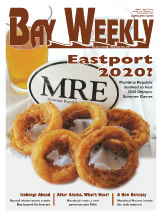Chesapeake Bay's Independent Newspaper ~ Since 1993
1629 Forest Drive, Annapolis, MD 21403 ~ 410-626-9888
Volume xviii, Issue 13 ~ Apri 1 to April 7, 2010
Home \\ Correspondence \\ from the Editor \\ Submit a Letter \\ Classifieds \\ Contact Us
Best of the Bay \\ Dining Guide \\ Home & Garden Guide \\ Archives \\ Distribution \\ Advertising![]()


Who’s Singing that Spring Song?The Song SparrowIn 1929, Margaret Morse Nice began to study a bird common in her Ohio backyard. Over nine years, she patiently watched song sparrows, recording every detail of their behavior. Through observation described by her biographer as “vast, difficult and mind boggling,” Nice was able to understand details of social interactions and learning behavior previously unremarked. She discovered that a species considered anti-social actually displayed a surprising number of social reactions and imitative tendencies that help individuals find food and stay safe. The eminent biologist Ernst Mayr credited Nice for “single-handedly initiating a new era in American ornithology.” She did her groundbreaking research without institutional support. While ornithologists focused on making lists of birds in the field and sometimes collecting specimens, Nice was a pioneer of recording life histories.
On awarding Nice an honorary Ph.D., the dean of Elmira College said, “She used the outdoors near her home as her laboratory and a common species of bird as her subject. In so doing, she joined the ranks of the eminent ornithologists of all time, who saw so much in what appeared common to so many.” We need people like Nice, with the patience and passion to look into the details of our natural world. To preserve and protect our environment, the scientific community needs to know complete stories. Learning to identify sparrows, as Nice did, can be overwhelming. First, learn the common ones: English or house (technically a weaver finch); chipping; field; song; and white-throated. Look them up in your field guide. You’ll see that generally, sparrows can be separated into two groups: clear-breasted and streak-breasted. Making this distinction narrows down the options when you try to make an I.D. If you see something that clearly doesn’t fit the description of the common five, remember to look at the breast. Then look for patterns on the head and wings that make this bird different from the ones you know. If you haven’t learned the common five, you’ll be out of luck.
The Field List of the Birds of Maryland (the Yellow Book), published by the Maryland Ornithological Society, uses graphs and keys to show the relative abundance, habitats and timing for all of the birds appearing locally. Song sparrows are easy to recognize. Their heavily streaked breast coalesces into a blotch in the middle of the chest. Coloration is uniformly brown on tan with some gray on the cheek and chestnut on the wing. On sunny spring days, I hear them sing whenever I step outside my door. The bird is aptly named because the song is a rhythmic, three-part series of notes and trills. It begins with an upbeat sequence of three clear notes, followed by three to four bouncy warbles and buzzes, then a pair of emphatic down beats. If you look for it you will find it, and you don’t need to be Margaret Morse Nice to learn its song. |
© COPYRIGHT 2010 by New Bay Enterprises, Inc. All rights reserved.

